Throughout human history, horses have been humanity’s go to for long distance travel or carrying out difficult tasks more easily. Horses were used for work, transport, in war and many other aspects of everyday life. However, since the invention of the motorised vehicle, they have become somewhat redundant in day-to-day life.

Horses & Humanity
There is evidence of humans domesticating the horse from around 5500 years ago. The horse was an important tool for developing humanity and allowing society to progress to the accomplishments we see today. After the domestication of horses, people could immediately travel longer distances, carry more capacity, and carry out tasks such as farming more easily.
From their beginning in the Eurasian steppes, horses quickly spread across the Earth as the domesticated helper we know today. The European explorers and settlers took them to lands on their overseas conquests such as America, where horses quickly adapted and became a huge part of life for natives and settlers alike.
The Switch to Motorised Vehicles
The Industrial Revolution showed us that machines were not just the future, but quickly the present, too. Horses weren’t just replaced overnight, however. They remained in place as one of our most valuable methods of both transportation and capacity carrying. There are famous pictures of horses still being utilised in battles as late as World War One, where an estimated eight million of them horrifically lost their lives. But, by the second world war, they were fairly redundant as cars and motorised weapons of war had become the main focus for industry and pedestrian alike.
When did cars replace horses?
The switch to cars happened very quickly, with the United States leading the charge of motorised vehicles. In a single decade, the American roads went from having just over 140,000 cars (in 1907) to close to five million by the end of the first world war in 1917. The number of commercial and agricultural vehicles with motorised solutions increased at an even greater rate in this period.
These numbers were also reflected in the horses too, with 22 million horses in 1925 but only 18 million five years later as there was less of a need to breed them at the rate they had been. Compared to cars on the other hand, the motorised vehicles rose from 20 million to over 26 million in the same period. By now, horses were far less commonly used as a transport method in North America and the rest of the world would soon follow.
Significant replacements were being made commercially too, with the Brooklyn fire department replacing its horse-drawn fire engine with a motorized version in 1922. It was a story that was repeated across the planet, as new technology came into reach for more and more people who had previously relied on equine power now no longer had a need for it.
For a horse, you’d either need to be trained in their upkeep, health conditions, often shoe fitting and maintenance, or the wealthy could hire a stable hand to do all of this. When the car came along, none of this was required. You may have needed a mechanic if you had an issue, but the day-to-day upkeep of your car was minimal compared to your four legged friend of previous requirement.
In Europe, the arrival of affordable, reliable cars in the 1920s led to the same replacement taking place, although it took longer in some countries than in others depending on their economic climate and acceptability to new normalities at the time.
In todays world, you often only need a car service on an regular MOT check to stay on top of your car requirements. Although it may not seem like it when you hear a clunking noise or you seen an engine light flash up, for the complexity of the inner workings of your car, they are incredibly reliable machines.
If you do have any issues with your car, you can take it down to a garage such as Advanced Service Centre, an MOT garage in Grays, Essex and they can have your car fixed and roadworthy within the same day.
Today, we can see horses used in agriculture and other jobs in developing countries where the cost of motorised vehicles are way too high and thus sticking to horses is a better option. There are still thought to be 27 million working horses in Africa for example.
The equine population dwindled at the start of the 20th century, as a result of the rise of motorisation, mostly. However, horses remain popular today thanks primarily to horse racing, the highly lucrative equestrian industry. In the US, there are estimated to still be close to four million horses and in the UK, the latest figures suggest that there were about 260,000 horses living here, some of which are bread for racing.
People all around the planet love to watch and bet on huge races like the Grand National, the Dubai World Cup and the Epsom Derby.
Horses are also still used in certain jobs where no technology has managed to replace them. These include use by mounted police offers to control crowds in a safe way and on cattle ranches. Horses can also be highly effective in more niche fields of work, such as searching for missing hikers in remote locations.
They are also used as an eco-friendlier alternative in some environmentally sensitive areas such as national parks or for companies who are concerned about their carbon footprint. While these animals will never again be used as widely as they once were, their adaptability means that they are still used in so many different areas to a very high standard, with some industries accepting there will never be a true replacement for the animal we have so much to thank for.